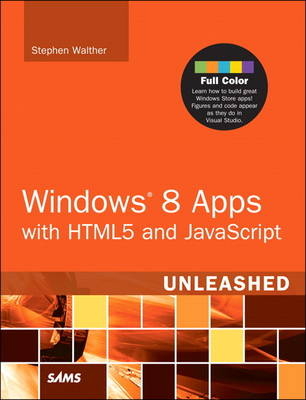
Windows 8 Apps with HTML5 and JavaScript Unleashed
Sams Publishing (Verlag)
978-0-672-33605-8 (ISBN)
- Titel ist leider vergriffen;
keine Neuauflage - Artikel merken
Offering the same deep insight and practical code that has made his ASP.NET Unleashed the #1 ASP.NET book of all time, Walther covers everything you need to build, test, and distribute outstanding Windows 8 software with JavaScript and HTML5.
Walther clearly demonstrates the unique advantages Windows 8 offers to web developers. He guides you through using Microsoft’s new WinJS library to develop apps for Microsoft’s brand-new version of Windows--you learn how to use JavaScript templates, controls, and data binding. You’ll find in-depth coverage of everything from displaying data with a ListView control to supporting SkyDrive cloud storage, creating games to using IndexedDB and HTML5 forms.
If you’re a web developer, Windows 8 gives you millions of new potential users--and you already have many of the skills you’ll need to reach them. Get this book, master the tools and techniques you don’t already know--and go after that huge new market!
Detailed information on how to...
Get your app published in the Windows Store
Create apps that work great with touch, keyboard, stylus, and mouse
Use JavaScript controls such as the Tooltip, Rating, DatePicker, and FlipView controls
Thoroughly master using the WinJS ListView control to display, sort, and filter data
Use HTML5 Canvas to build arcade games
Store data on the local file system, via remote web services, or in IndexedDB databases
Use Live Services to authenticate users, retrieve user profiles, and interact with SkyDrive
Create custom WinJS controls with Page Controls
Build apps that gracefully adapt to different screen resolutions and orientations
Take pictures from your computer’s webcam and play sounds
Formerly a Senior Program Manager at Microsoft, Stephen Walther now runs his own consulting and training company, www.SuperexpertTraining.com. He flies to companies and provides hands-on training on building Windows Store apps. Stephen was completing his Ph.D. at MIT and teaching classes on metaphysics at MIT and Harvard when he abruptly realized that there is no money in metaphysics. He dropped out to help found two successful Internet startups. He created the Collegescape website, a website used by more than 200 colleges including Stanford, Harvard, and MIT for online college applications (sold to ETS). He also was a founder of CityAuction, which was one of the first and largest auction websites (sold to CitySearch).
Introduction 1
1 Building Windows Store Apps 5
What Is a Windows Store App? 5
Microsoft Design Style Principles 6
Common Features of Windows Store Apps 8
Creating Your First Windows Store App 13
Creating the Visual Studio Project 13
Declaring App Capabilities 15
Creating the HTML Page 16
Creating the Style Sheet 17
Creating the JavaScript File
Running the App 20
Elements of a Windows Store App 21
JavaScript 21
HTML5 21
Cascading Style Sheets 3 22
Windows Runtime 22
Windows Library for JavaScript 23
What about jQuery? 23
Building Windows Store Apps with Visual Studio 26
Windows Store App Project Templates 26
Running a Windows Store App 34
Debugging a Windows Store App 35
Using the Visual Studio JavaScript Console Window 35
Setting Breakpoints 37
Using the DOM Explorer 37
Publishing to the Windows Store 38
Register as a Windows Developer 38
Submitting Your App 39
Passing App Certification 41
Summary 42
2 WinJS Fundamentals 45
Namespaces, Modules, and Classes 45
Using Namespaces 46
Using the Module Pattern 48
Using Classes 51
Asynchronous Programming with Promises 56
Using Promises 57
Using then() versus done() 58
Creating Promises
Creating a Timeout Promise 61
Canceling Promises 62
Composing Promises 63
Retrieving DOM Elements with Query Selectors 63
Performing Queries with the WinJS.Utilities.query() Method 64
Retrieving a Single Element with the WinJS.Utilities.id() Method 66
Using the WinJS.Utilities.children() Method 67
Working with the QueryCollection Class 68
Performing Ajax Calls with the xhr Function 69
Specifying Different Response Types 72
Customizing the Properties of the XmlHttpRequest Object 73
Summary 75
3 Observables, Bindings, and Templates 77
Understanding Observables 77
Creating an Observable 78
Creating Observable Listeners 79
Coalescing Notifications 81
Bypassing Notifications 82
Working with the WinJS.Binding.List Object 83
Creating an Observable Collection of Observables 86
Understanding Declarative Data Binding 86
Declarative Data Binding and Observables 89
Capturing the Contents of an HTML Form 91
Declarative Data Binding and WinJS Controls 94
Declarative Data Binding and Binding Converters 96
Understanding Templates 100
Creating an Imperative Template 100
Creating a Declarative Template 103
Applying a Template with a Query Selector 104
Creating External Templates 106
Summary 108
4 Using WinJS Controls 109
Introduction to WinJS Controls 109
Creating a WinJS Control Declaratively 111
Creating Controls Imperatively 113
Setting Control Options 114
Retrieving Controls from an HTML Document 115
Using the Tooltip Control 116
Using the contentElement Property 117
Styling a Tooltip 117
Using the ToggleSwitch Control 118
Determining the State of a ToggleSwitch 118
Using the Rating Control 120
Customizing the Ratings 121
Submitting a Rating 121
Using the DatePicker Control 123
Formatting the Year, Month, and Date 124
Displaying Only Years, Months, or Days 126
Capturing the Selected Date 127
Using the TimePicker Control 128
Getting and Setting the Current Time 130
Formatting the Hour, Minute, and Period 131
Using the FlipView Control 132
Displaying Page Numbers 135
Creating Custom FlipView Buttons 137
Summary 139
5 Creating Forms 141
Using HTML5 Form Validation 141
Using the required Attribute 142
Using the pattern Attribute 142
Performing Custom Validation 143
Customizing the Validation Error Style 144
Resetting a Form 146
Using HTML5 Input Elements
Labeling Form Fields 148
Entering a Number 149
Entering a Value from a Range of Values 151
Entering Email Addresses, URLs, Telephone Numbers, and Search Terms 151
Entering a Value from a List of Values 153
Selecting Files 154
Creating a Rich Text Editor 155
Displaying Progress 156
Summary 158
6 Menus and Flyouts 161
Using the Flyout Control 161
Using the Menu Control 163
Using the AppBar Control 167
Creating a Simple App Bar 168
Using App Bar Commands 170
Showing Contextual Commands 173
Configuring App Settings 175
Creating About Page Settings. 176
Creating Personal Settings 178
Displaying Windows Dialogs 182
Summary 184
7 Using the ListView Control 185
Introduction to the ListView Control 185
Using List Layout versus Grid Layout 190
Preventing Overlapping ListView Items 193
Selecting Items in a ListView Control 197
Creating a Master/Detail View 198
Selecting Multiple Items 202
Sorting Items in a ListView Control 204
Filtering Items in a ListView Control 206
Grouping Items in a ListView Control 208
Switching Views with Semantic Zoom 211
Switching a ListView Template Dynamically 216
Loading ListView Items Incrementally 219
Summary 221
8 Creating Data Sources 223
Creating Custom Data Sources 223
Creating the Data Source Class 224
Creating a Data Adapter 224
Implementing the getCount() Method 225
Implementing the itemsFromIndex() Method 225
Implementing the insertAtEnd() Method 227
Implementing the remove() Method 227
Implementing the change() Method 228
Handling Errors 228
Implementing the setNotificationHandler() Method 229
Creating a File Data Source 230
Using the File Data Source 231
Creating a Web Service Data Source 236
Creating the Data Source 236
Creating the Web Service 237
Using the Web Service Data Source 240
Creating an IndexedDB Data Source 241
Overview of IndexedDB 241
Using the IndexedDB Data Source 245
Summary 252
9 App Events and States 253
App Events 253
Handling the Activated Event 254
Handling the Error Event 255
Deferring Events with Promises 256
Creating Custom Events 257
Suspending, Terminating, and Resuming an App 257
Detecting When an App Is Suspended and Terminated 258
Detecting the Previous Execution State 258
Testing Application State with Visual Studio 259
Storing State with Session State 260
Application View States 61
Snapped, Filled, Portrait, and Landscape 261
Using Media Queries 264
Using the JavaScript mediaMatch Method 266
Defining a Viewport 267
Summary 270
10 Page Fragments and Navigation 273
Using the HtmlControl Control 273
Creating a Page Control 276
Creating Multipage Apps 280
Creating a Navigation App 280
Understanding the Navigation App default.html Page 281
Adding New Page Controls to a Navigation App 283
Navigating to Another Page 285
Understanding the Navigation API 286
Understanding the PageControlNavigator Control 287
Understanding Navigation State 287
Summary 291
11 Using the Live Connect API 293
Installing the Live SDK 294
Adding a Reference to the Live SDK 294
Registering Your App 294
Initializing the Live Connect SDK 296
Specifying Different Scopes 296
Authenticating a User 299
Using WL.login() 299
Using the SignIn Control 300
Authentication Events 302
Passing an Authentication Token to a Web Service 303
Sending the Authentication Token from a Windows Store App 303
Verifying the Authentication Token in a Web Service 306
Retrieving the User ID 308
Retrieving Basic User Information 309
Uploading and Downloading Files from SkyDrive 311
Listing SkyDrive Folders and Files 312
Downloading Files from SkyDrive 314
Uploading Files to SkyDrive 316
Summary 318
12 Graphics and Games 319
Overview of the Game 320
Creating the Game Tiles 321
Playing the Game Sounds 322
Creating the Game Canvas 323
Capturing User Interaction 325
Creating the Update Loop 327
Creating the Render Loop 329
Summary 331
Index 333
| Erscheint lt. Verlag | 5.12.2012 |
|---|---|
| Verlagsort | Indianapolis |
| Sprache | englisch |
| Maße | 182 x 232 mm |
| Gewicht | 692 g |
| Themenwelt | Informatik ► Betriebssysteme / Server ► Windows |
| Informatik ► Software Entwicklung ► Mobile- / App-Entwicklung | |
| Informatik ► Weitere Themen ► Smartphones / Tablets | |
| ISBN-10 | 0-672-33605-7 / 0672336057 |
| ISBN-13 | 978-0-672-33605-8 / 9780672336058 |
| Zustand | Neuware |
| Informationen gemäß Produktsicherheitsverordnung (GPSR) | |
| Haben Sie eine Frage zum Produkt? |
aus dem Bereich


